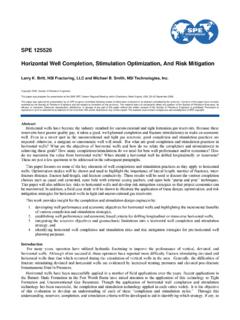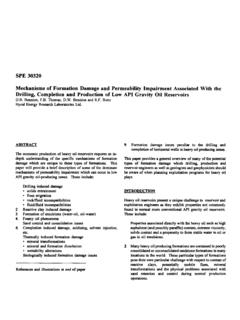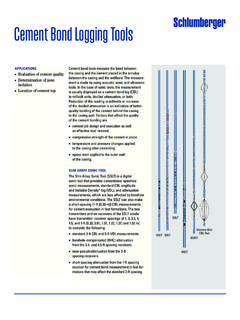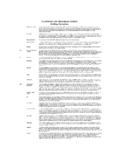Transcription of Horizontal And Multilateral Well Technology
1 UNESCO EOLSSSAMPLE CHAPTERSPETROLEUM ENGINEERING UPSTREAM - Horizontal And Multilateral well Technology - Sada Joshi Encyclopedia of Life Support Systems(EOLSS) Horizontal AND Multilateral well Technology Sada Joshi Joshi Technologies International, Inc., Tulsa, Oklahoma, USA Keywords: Horizontal well , Multilateral well , slant well , fracturing, gas coning, water coning, water flooding, mud motors, angle build motor, casing, porosity, permeability, permeability ratio, turn radius, ultra short radius, short radius, knuckle joint, downhole, total vertical depth (TVD), well tolerance, stand-off, kick-off, formation damage, coiled tubing, artificial lift or pump, pressure drawdown.
2 Contents 1. Introduction Field Development Plans Application Reasons for Drilling Horizontal Wells and Productivity Improvement Enhancement of Reserves Economic Reasons 2. Drilling Methods 3. Completion of Horizontal Wells Open Hole Completions Slotted Liners External Casing Packers (ECP) Cemented and Perforated Liners 4. Horizontal well Productivity Steady State Productivity of a Horizontal Gas well Important Parameters for Horizontal well Productivity Influence of Permeability Ratio, vh/kk Influence of Formation Damage Influence of Producing well Length Influence of Pressure Drop in the Wellbore 5.
3 Multilateral Wells Multilateral Completion Types Productivity of Multilateral Wells 6. Horizontal well Planning Acknowledgements Glossary Bibliography Biographical Sketch Summary Since 1980, progressively more and more Horizontal wells and Multilateral wells are being used for the development and production of oil and gas fields around the globe. This chapter includes a summary of Horizontal and Multilateral well Technology as of 2007. UNESCO EOLSSSAMPLE CHAPTERSPETROLEUM ENGINEERING UPSTREAM - Horizontal And Multilateral well Technology - Sada Joshi Encyclopedia of Life Support Systems(EOLSS) The chapter also describes various oil fields where Horizontal and Multilateral wells are used.
4 A Horizontal well is one that is typically drilled parallel to the bedding plane of an oil or gas bearing reservoir. Drilling 2000 to 3000 ft (600 to 900 m) long wells has become quite common. The main reasons for drilling Horizontal wells are: 1) their stabilized production rate is about 2 to 5 times more than that of vertical wells, 2) depending upon the location and type of drilling technique used, the cost of a Horizontal well is to 2 times the cost of conventional wells, and 3) the cumulative oil and/or gas produced by a Horizontal well is about 2 to 6 times more than that of a conventional vertical well .
5 In short, Horizontal wells generally provide better economics than conventional wells. This chapter includes descriptions of: 1) types of Horizontal wells and the techniques used to drill them, 2) how to complete and produce Horizontal wells, 3) mathematical equations to estimate production rates from Horizontal and Multilateral wells, and 4) various parameters that influence productivity of Horizontal wells. Additionally, the chapter includes several field histories of Horizontal and Multilateral applications.
6 1. Introduction A Horizontal well is drilled parallel to the reservoir bedding plane, whereas a vertical well intersects the reservoir bedding plane at 90 degrees. A slant well would be one that intersects the reservoir at an angle (see Figure 1). Figure 1. A) Schematic of a vertical well , B) Schematic of a slant well with angle , C) Schematic of a Horizontal well Multilateral well drilling involves the drilling of two or more Horizontal production holes from a single surface location (see Figure 2).
7 The normal objective of both Horizontal and Multilateral wells is to produce more oil or gas from a well and to reduce the overall cost of producing each barrel of oil or each cubic foot of gas. UNESCO EOLSSSAMPLE CHAPTERSPETROLEUM ENGINEERING UPSTREAM - Horizontal And Multilateral well Technology - Sada Joshi Encyclopedia of Life Support Systems(EOLSS) Figure 2. Multilateral well Configurations Generally, the productivity of a Horizontal well is two to five times more than the productivity of a vertical well .
8 This productivity improvement occurs because of the contact area between the reservoir and the well . Oil and gas reservoirs generally vary in thickness from 20 ft to 300 ft (6 to 90 m). Thus, with a conventional vertical well , the contact area between the well and the reservoir is 20 ft to 300 ft (6 to 90 m), depending upon the reservoir thickness. In a Horizontal well , a typical well length is 2000 ft to 3000 ft (600 to 900 m) long, resulting in a very long contact area between the well and the reservoir.
9 Hence, a Horizontal well provides 10 to 200 times more contact area with the reservoir than the contact area provided by a vertical well . This large contact area results in higher well productivity for Horizontal wells as compared to vertical wells. Although the common length of a Horizontal well is 2000 ft to 3000 ft (600 to 900 m), Horizontal wells as long as 8 km have been drilled. Such long wells provide a very long producing length and high well productivity. How far one can drill depends upon the mechanical capacity of the drilling rig.
10 The torque, drag, and weight of the drilling pipe and the casing weight that can be handled by the rig determine how long one can drill. Additionally, the reservoir thickness will also determine how long one can drill. In thin zones, it is difficult to stay in the zone for a very long length. On the other hand, if the reservoir is thick, it may be easier to drill long wells without wandering out of the zone while drilling. Figure 3 shows a typical Horizontal well . As seen here, there are four producing layers and the well intersects more than one layer and is not exactly Horizontal .













